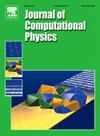高雷诺数壁面湍流大涡模拟的全剪切应力守恒壁面模型
IF 3.8
2区 物理与天体物理
Q2 COMPUTER SCIENCE, INTERDISCIPLINARY APPLICATIONS
引用次数: 0
摘要
壁型大涡模拟(WMLES)被广泛认为是模拟高雷诺数湍流的一种有效方法。然而,在不同的壁面模型中,一个持续存在的问题是平均速度剖面从壁面模型/RANS (reynolds -average Navier-Stokes)区域向LES区域的转移。这种现象被称为对数层错配(LLM),在壁面剪切应力模型和混合RANS/LES模型中都存在。为了解释和解决这种不匹配,已经做了很多努力,包括降低匹配层壁面剪切应力与速度之间的高相关性,修改亚网格尺度(SGS)涡动粘度,以及添加随机强迫。人们普遍认为,包含已分解的雷诺剪切应力(或对流项)对于消除LLM至关重要,因为它可以防止模型中雷诺剪切应力的高估,并促进近壁区域小尺度流动结构的产生。通过比较三种不同的SGS涡流黏度模型,我们证明了确保总剪切应力守恒(TSSC)约束是求解LLM的关键。在TSSC框架下,可以定量评价对流项对LLM的影响。此外,在不同雷诺数(Reτ=1000,2000,4200)下,对符合TSSC约束的修正SGS涡流粘度修正模型进行了测试。我们的结果表明,即使在相对较低的网格分辨率下(Δx+,Δz+≤500,2≤Δx/Δy,mat≤4,其中Δy,mat是墙-模型区域的墙-法向网格间距),该模型在预测皮肤摩擦和低阶湍流统计方面也具有鲁棒性。本文章由计算机程序翻译,如有差异,请以英文原文为准。

A total-shear-stress-conserved wall model for large-eddy simulation of high-Reynolds number wall turbulence
Wall-modeled large-eddy simulation (WMLES) is widely recognized as a useful method for simulation of turbulent flows at high Reynolds numbers. Nevertheless, a continual issue in different wall models is the shift of the mean velocity profile from the wall-model/RANS (Reynolds-averaged Navier-Stokes) region to the LES region. This phenomenon, referred to as logarithmic layer mismatch (LLM), occurs in both wall shear stress models and hybrid RANS/LES models. Many efforts have been made to explain and resolve this mismatch, including decreasing the high correlation between the wall shear stress and the velocity at the matching layer, modifying the subgrid-scale (SGS) eddy viscosity, and adding a stochastic forcing. It is widely believed that the inclusion of the resolved Reynolds shear stress (or the convection term) is essential to eliminate the LLM, as it prevents the overestimation of the modeled Reynolds shear stress and promotes the generation of the small-scale flow structures in the near-wall region. In this work, by comparing three different SGS eddy viscosity models, we demonstrate that ensuring the total-shear-stress-conserved (TSSC) constraint is key to resolving the LLM. Under the TSSC framework, the effect of the convection term on LLM can be quantitatively assessed. Furthermore, a modified SGS eddy viscosity modification model that adheres to the TSSC constraint is tested at different Reynolds numbers (). Our results demonstrate the robust performance of the present model in predicting skin friction and low-order turbulence statistics, even under a relatively low grid resolution (, , where is the wall-normal grid spacing in the wall-model region).
求助全文
通过发布文献求助,成功后即可免费获取论文全文。
去求助
来源期刊

Journal of Computational Physics
物理-计算机:跨学科应用
CiteScore
7.60
自引率
14.60%
发文量
763
审稿时长
5.8 months
期刊介绍:
Journal of Computational Physics thoroughly treats the computational aspects of physical problems, presenting techniques for the numerical solution of mathematical equations arising in all areas of physics. The journal seeks to emphasize methods that cross disciplinary boundaries.
The Journal of Computational Physics also publishes short notes of 4 pages or less (including figures, tables, and references but excluding title pages). Letters to the Editor commenting on articles already published in this Journal will also be considered. Neither notes nor letters should have an abstract.
 求助内容:
求助内容: 应助结果提醒方式:
应助结果提醒方式:


